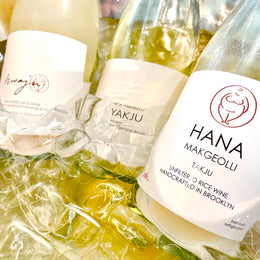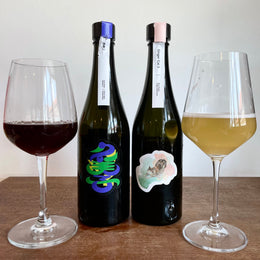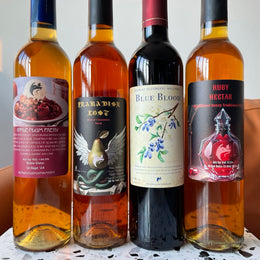
Water from Lake Ladoga in Russia, which is said to be used in the distillation of Russian Standard Vodka.
Did you know that "vodka" means "Little Water" in Russia? It's true, Google it! When it comes to vodka, Russians are undoubtedly the maestros of the craft. Granted, while there are many Russian vodka brands that are well-known globally, some like Stoli and Smirnoffs aren't actually still produced within Russia itself.
The one Russian owned and Russian made vodka brand that is fairly popular and widely distributed globally is Russian Standard. In 1998, the vodka was launched by Roustam Tariko, who also founded the Russian Standard Bank, a credit card operation and a term life insurer in Russia. In 2000, the brand started exporting internationally after some success in the domestic market, and soon followed up with the launch of new vodka products, such as the Russian Standard Platinum in 2001 and luxury brand Imperia in 2004.
Russian Standard Vodka recently gained renewed attention since the commencement of the Russian Ukraine war, having been one of the Russian owned and Russian produced brands that were pulled off American shelves amidst retail boycotts. It's still fairly widely available in Asia, and often recommended as a value for money vodka for mixing and shots.

The new Imperia Vodka line was marketed as a "premium" version of the original Russian Standard.

The vodka itself made from winter barley from the Russian steppes. This kind of barley is broadly known as winter grain, or cereal crops sown in the autumn and are harvested earlier as compared to their springtime counterparts. Water from Lake Ladoga is used in the production process, where the lake's underground sources is said to provide one of the softest waters naturally available. Notably, the vodka is filtered four times through birch charcoal, which reportedly contributes to its smoothness.

Professor Mendeleev's 1865 doctoral dissertation "A Discourse on the combination of alcohol and water" was used as the basis for Russian Standard's marketing.
The name "Russian Standard" is a reference to the Inventor of the Periodic Table, Professor Dmitri Mendeleev. Apparently, the professor's doctoral thesis work led him to discover the perfect balance between water and alcohol, which was a ABV of 38%, and he was later commissioned to set the 'Russian Standard' for how Russian vodka should be made.
We're big fans of alcohol lore here! Though, unfortunately, the above story is just a fictional marketing anecdote. In reality, Mendeleev was merely 9 years old when the 40% standard strength for Russian vodkas was introduced by the Russian government back in 1843 - and couldn't possibly have been consulted in the process.
Russian Standard Vodka, 38% AVBV - Tasting Notes

Tasting Notes
Colour: Clear
Aroma: There’s really not much here at all - not even a prickle or burn - nor is there really any scent. There is a creamy quality to it, like a completely flavourless cream, maybe the slightest hint of vanilla cream. Really struggling to pick up anything here - maybe a slight bit of rubbing alcohol.
Taste: Again! There’s nothing here! It’s almost comparable to water, but here it’s more creamy in texture. Really smooth, with a very nice weight to it. The slightest sense of vanilla cream sweetness. It’s very, very soft.
Finish: A slight hit of peppercorn, but again, incredibly smooth, pretty much no burn at all. Very nice cleanness to it, with not much crispness either.

My Thoughts
Recall that Vodka is meant to have no scent and no taste - but of course these days we’ve gone off the deep end with a whole lot of flavoured Vodka’s, and even those that are not flavoured do come with a slight bit of extract from whatever the Vodka is made of. But Russian Standard really stays true to that mantra - it is totally nothing!
And that actually makes it a very good Vodka! For the most part it’s just really creamy and has an incredible softness to it. You’ll struggle to even find that alcohol prickle, and even on the finish it’s more of a black peppercorn kind of hit than that of an alcohol burn, in that it’s a little more earthy. If I squeeze my imagination real hard, there might be something of vanilla cream, but I err on the side that it’s really because I find it hard to detect any other flavour to the creaminess.
What I do like is how soft and mellow it is on both the aroma and the texture on the palate. It’s almost like a flavourless yet rich cream. It’s incredibly close to water, although here it has a creamy and glistening quality to it that’s brighter and more uplifting - but put really cold water beside a really chilled bottle of Russian Standard, and you might have a tough time telling the difference.
This is once again a well-made Vodka that I think would work best in a simple mixer. If you’re doing Cranberry & Vodka - this is it. I wouldn’t necessarily do shots with it because it doesn’t have that burn and crispness that’s very satisfying, and I wouldn’t quite use this in a more complex cocktail because it doesn’t really add much to the cocktail, and then finally I don’t think I’d sip on this because there’s not much to work off on.
It’s really quite impressive, this Russian Standard, and whilst it is very friendly and approachable, it’s really suffering from its success where it’s alittle too neutral and has really not any character to do anything with it, aside from use it as a mixer.
 |
Lok Bing Hong A budding journalist that loves experiencing new things and telling people's stories. I have 30 seconds of coherence a day. I do not decide when they come. They are not consecutive. |







